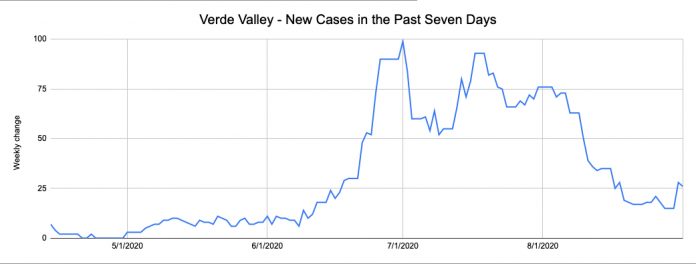In the week from Friday, Aug. 21 through Friday Aug. 28, there were just 15 new confirmed COVID cases in the Verde Valley, representing an increase of just 2.23% from the previous week. This represents the smallest increase in cases in the area since the early weeks of June, before a wave of COVID infections hit Yavapai County. That wave of infections peaked the week from June 24 through July 1, at 99 new positive cases.
“Based on state metrics, we fall into a moderate spread category, and even within that I think we’re pretty low,” Yavapai County Community Health Services Director Leslie Horton said. “We’re almost, in some [benchmarks] into a minimal spread category.”
Horton said that with tests up higher than ever — such as blitz testing in Sedona and Prescott this past weekend — the decline does not represent just a failure to find cases but a real decline in the amount of new cases in the area.
“We are really seeing a good trend,” Horton said. “Our positivity rate has been around 2 to 3 percent.”
As of Monday, there were a total of 707 confirmed cases in the Verde Valley. Cottonwood has 271 cases, Sedona has 106 cases, the Village of Oak Creek has 34, Camp Verde has 151, Cornville has 32, Rimrock has 48 and Clarkdale has 64, with one additional case elsewhere in the Verde Valley. Yavapai County has a total of 2,307 cases, a 2.2% increase on the previous week.
Since the beginning of the pandemic, a total of 28 deaths have been officially recorded in the Verde Valley, 16 of which were in Cottonwood.
At Verde Valley Medical Center, there are as of Monday just 3 positive cases, with one pending test. According to VVMC Chief Administrative Officer Ron Haase, the maximum for the hospital during the outbreak was 23 cases. The hospital census is at 44, well below the threshold of 70 that would require the hospital to start making efforts to keep beds empty for a potential surge. The hospital, which now allows elective surgeries but makes an effort to do so as outpatient procedures to have as few patients staying over at the facility as possible, is considering shifting its guest policies to allow visitors at the hospital, if they can be checked for symptoms and wear protective gear.
“I think we’ve been very fortunate because of where we’re at,” Haase said. “The population density here is not what it would be like in a major metropolitan area. I do think that for the most part, [people] — not everybody — has adhered to a lot of the CDC guidelines of social distancing, and masking, and washing hands, and all of those kinds of things. I do think we’re seeing a dip in the number of cases.”
With the fall in cases and hospitalizations, Yavapai County is one of few places in Arizona that has met its benchmarks for reopening. Schools in Camp Verde and Sedona have opened, and some bars in the area, which had to close after reopening when the outbreak hit Arizona in the early part of the summer, have begun to reopen their doors
Despite the good news, Horton and other public health officials continue to urge residents to use caution and continue social distancing when possible, as well as wear masks when in close contact with strangers. Horton recommended people find ways to spend time outside in order to maintain their emotional and physical health while still being careful about the virus.
“The things we’ve been doing — [they’re] working,” Horton said. “The last thing I want to see is for schools to start reopening and businesses to start reopening, and then have to close again.”
Haase said that he expected based on the previous behavior of the virus in the area, that cases could likely go up again in the future, even with good news of the virus now.
“We sort of hold our breath here, because none of us know what may happen,” Haase said. “I think we’re gonna see coronavirus around for a while. It’s going to still take people’s lives. That’s going to be unfortunate.”
“We do still have COVID in the community,” Horton said. “There’s always that capacity in our community right now to have an outbreak, and one really infectious person could still infect a lot of people in our community, and therefore we ask that [while] people can definitely appreciate that our numbers are lower and our risk of contracting COVID right now is much lower than it was back in July, we ask that people stay vigilant … especially when we look towards opening schools and opening bars and other busi- nesses that would be considered higher risk for spread. We want to make sure we can open those and hopefully not see changes in case numbers.”



